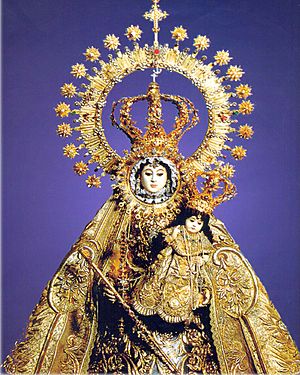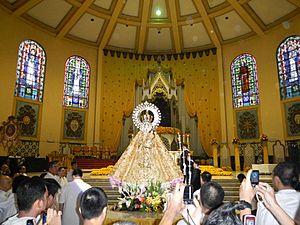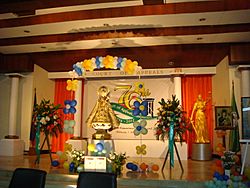Our Lady of La Naval de Manila facts for kids
Quick facts for kids Our Lady of the Most Holy Rosary |
|
|---|---|

The image wearing the Numero Uno vestment, used for the 1907 canonical coronation.
|
|
| Location | Quezon City, Philippines |
| Date | 1593? 1596? |
| Type | Ivory, wood statue |
| Approval | Pope Pius X 5 October 1907 |
| Shrine | National Shrine of Our Lady of the Most Holy Rosary, Santo Domingo Church, Quezon Avenue, Quezon City, Philippines |
| Patronage | Philippine Navy Quezon City |
| Feast day | Second Sunday of October |
Our Lady of the Most Holy Rosary — La Naval de Manila is a special title given to the Blessed Virgin Mary in the Philippines. It is connected to a famous statue.
Many people believe that the Virgin Mary, under this title, helped the Spanish and Filipino forces. They say she helped them win against the Dutch Republic during the Battles of La Naval de Manila in 1646. The Dutch were trying to invade the Philippines at that time.
In 1906, Pope Pius X officially recognized the statue with a special honor called a canonical coronation. This ceremony happened on October 5, 1907. In 2009, the Philippine government declared the statue and its church a National Cultural Treasure. This means it is a very important part of the country's heritage.
Contents
The Statue of Our Lady
The statue is about four feet and eight inches tall. Its body is made of hardwood, shaped like a cage. The face and hands, along with the entire statue of the Child Jesus, are made from solid ivory.
This statue is thought to be the oldest ivory carving in the Philippines. Since it was made, it has always been dressed in fancy clothes and a crown.
In 1907, about 310,000 people, including professors from the University of Santo Tomas, gave their family jewels. They donated gemstones, gold, and silver for the statue's special coronation. These gifts are now part of the statue's large collection of beautiful decorations. Some of these pieces are very old, dating back to the 1700s.
Special Papal Honors
The statue has received several special honors from different Popes.
- In 1903, Pope Leo XIII, known as the "Rosary Pope," wrote a letter. He encouraged people to visit the Virgin Mary's shrine in Santo Domingo Church. He said:
"...Go to the temple of Santo Domingo, to the sanctuary of the excellence of the Most Holy Virgin of the Rosary in the Philippines, to the place where your elders bent their knees to give thanks to her who liberated these Islands from Protestant heresy, to the spot consecrated by the piety of one hundred generations who had gone there to deposit their piety and confidence in Mary most holy...
Leone XIII, P.P. "
- Pope Pius X approved the statue's Canonical Coronation in 1906. The ceremony was performed by Archbishop Dom Ambrose Agius on October 5, 1907.
- Pope Pius XII also sent a special letter in 1946. This was to celebrate 300 years since the Battle of La Naval de Manila.
- Pope Paul VI named her the special protector of Quezon City in 1973. The statue's church was rebuilt there after Manila was destroyed in World War II.
- Pope John Paul II dedicated the entire continent of Asia to this title in 1981. He used a copy of the statue for this special event. The next day, he blessed the original statue during a public church service.
History of the Statue
In 1593, the new Spanish Governor-General of the Philippines, Luis Pérez Dasmariñas, ordered a statue of Our Lady of the Rosary. He wanted it made to honor his father, who had recently passed away.
A Chinese immigrant, who later became a Christian, carved the statue. This is why the statue has Asian features. The statue was then given to the Dominican friars. They placed it in the Santo Domingo Church.
In 1646, the Dutch Republic tried many times to take over the Philippines. They wanted to control trade in Asia. The Spanish and Filipino soldiers who fought asked for the Virgin Mary's help before the battles.
They were told to pray the rosary often and ask for her protection. The combined forces fought five major sea battles against the stronger Dutch fleet. They lost only fifteen Spanish Navy members. After the Dutch left, the survivors walked barefoot to the shrine. They did this to thank the Virgin Mary for their victory.
On April 9, 1662, church leaders in Manila declared the naval victory a miracle. They said it happened because of the Virgin Mary's help. They announced that the miracle should be celebrated and remembered.
Later Events and Recognition
In 1906, Pope Pius X allowed the statue to receive a special crown. This was given by Ambrose Agius, a church leader in the Philippines.
During the Japanese bombing in 1942, church officials hid the statue. They feared it would be destroyed. It was kept safe at the University of Santo Tomas until 1946. This was the 300th anniversary of the battles.
In October 1954, the statue was moved to a new church in Quezon City. This was the sixth Santo Domingo Church built since the late 1500s. For this journey, people built a special boat-shaped carriage. This carriage carried the statue to its new home. The church was then named her National Shrine.
In October 1973, La Naval was officially named the special protector of Quezon City. At that time, Quezon City was the capital of the Philippines. In 1975, she was also declared the protector of the Philippine Navy. This protection is still honored today.
The People Power Revolution
During the People Power Revolution in February 1986, a copy of the statue was carried in a procession. It went to the Malacañan Palace, the president's home. This was a peaceful protest against the strict rule of President Ferdinand Marcos.
The copy of the statue was also brought to Camp Crame. This was the police headquarters where rebel forces were staying during the uprising. Many Filipino Catholics believe the revolution's peaceful success was due to the Virgin Mary's help.
Filipino historian Nick Joaquín wrote about one of the red jewels in the statue's crowns. He said it came from an old story about a giant serpent in the Pasig River. This folktale might be a way to show how Christianity won over older beliefs. Another crown was supposedly given by King Norodom of Cambodia in 1872.
Recent Events
The funeral of former senator Benigno Aquino Jr. was held at the statue's church. This happened after he was killed in August 1983. Other important funerals held there include those of actor Fernando Poe Jr. in 2004 and Doña María Ejercito, the mother of former President Joseph Estrada, in 2009.
In 2009, journalist Korina Sanchez married Senator Manuel A. Roxas II in front of the statue. This wedding was shown on television.
In December 2011, the Eternal Word Television Network featured the statue. They called it the "Grandest Marian Icon in the Philippines" on their show.
The statue, its church, and other items there were declared a "National Cultural Treasure" in 2012. This was announced by the National Museum of the Philippines.
In 2020, the annual celebration for Our Lady of La Naval was simpler. It lasted for 15 days but did not have the usual large events. This was because of the COVID-19 pandemic. The same happened in 2021, but some events were streamed online, and a few people were allowed to attend.
Images for kids
-
Processional banner of Our Lady of the Most Holy Rosary of La Naval. Below the Virgin's image are the arms of Vatican City, the arms of the Republic, and the arms of the Dominican Order.
See also
 In Spanish: Nuestra Señora de La Naval de Manila para niños
In Spanish: Nuestra Señora de La Naval de Manila para niños
- Catholic Church in the Philippines
- Cathedral Basilica of the Immaculate Conception
- Santo Niño de Cebu
- Our Lady of Manaoag
- Roman Catholic Diocese of Cubao
- Quezon City











